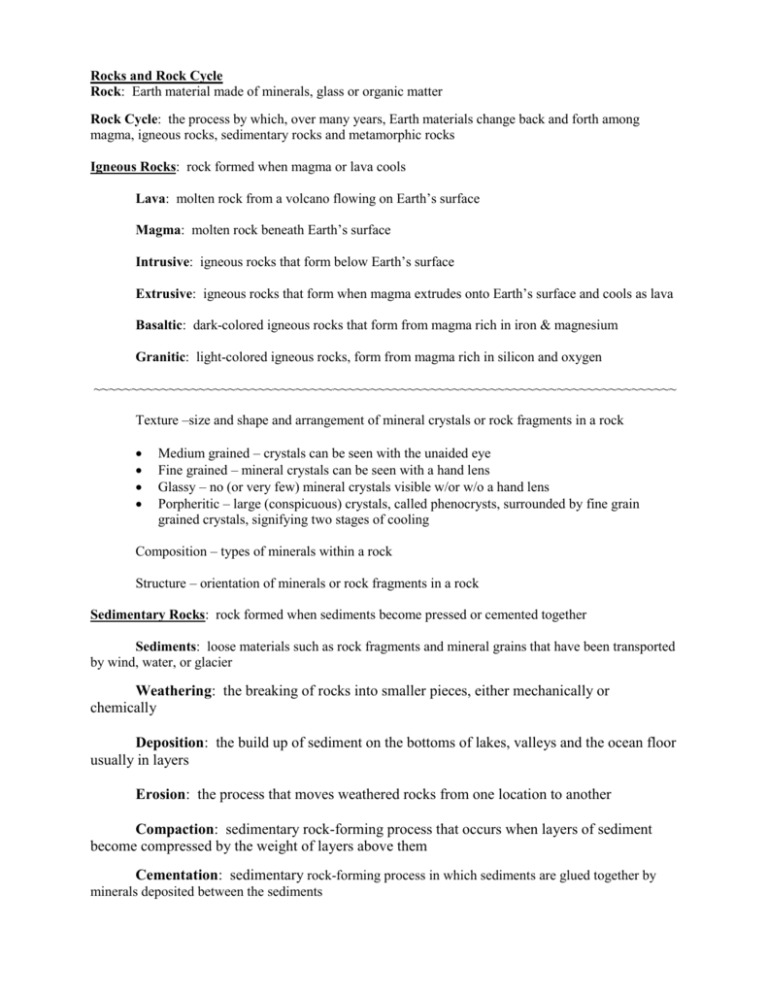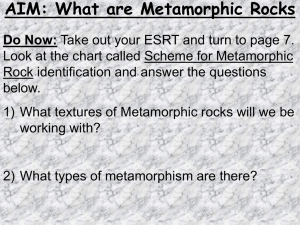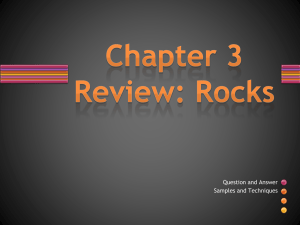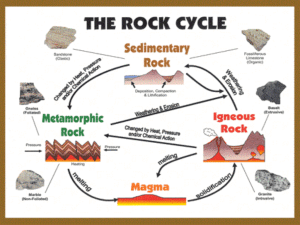Rock: Earth material made of minerals, glass or organic matter
advertisement

Rocks and Rock Cycle Rock: Earth material made of minerals, glass or organic matter Rock Cycle: the process by which, over many years, Earth materials change back and forth among magma, igneous rocks, sedimentary rocks and metamorphic rocks Igneous Rocks: rock formed when magma or lava cools Lava: molten rock from a volcano flowing on Earth’s surface Magma: molten rock beneath Earth’s surface Intrusive: igneous rocks that form below Earth’s surface Extrusive: igneous rocks that form when magma extrudes onto Earth’s surface and cools as lava Basaltic: dark-colored igneous rocks that form from magma rich in iron & magnesium Granitic: light-colored igneous rocks, form from magma rich in silicon and oxygen ~~~~~~~~~~~~~~~~~~~~~~~~~~~~~~~~~~~~~~~~~~~~~~~~~~~~~~~~~~~~~~~~~~~~~~~~~~~~~~ Texture –size and shape and arrangement of mineral crystals or rock fragments in a rock Medium grained – crystals can be seen with the unaided eye Fine grained – mineral crystals can be seen with a hand lens Glassy – no (or very few) mineral crystals visible w/or w/o a hand lens Porpheritic – large (conspicuous) crystals, called phenocrysts, surrounded by fine grain grained crystals, signifying two stages of cooling Composition – types of minerals within a rock Structure – orientation of minerals or rock fragments in a rock Sedimentary Rocks: rock formed when sediments become pressed or cemented together Sediments: loose materials such as rock fragments and mineral grains that have been transported by wind, water, or glacier Weathering: the breaking of rocks into smaller pieces, either mechanically or chemically Deposition: the build up of sediment on the bottoms of lakes, valleys and the ocean floor usually in layers Erosion: the process that moves weathered rocks from one location to another Compaction: sedimentary rock-forming process that occurs when layers of sediment become compressed by the weight of layers above them Cementation: sedimentary rock-forming process in which sediments are glued together by minerals deposited between the sediments Clastic Sedimentary Rock: made of broken fragments of plants, animals, and primarily other rocks Chemical Sedimentary Rock: made from minerals precipitated from a solution or are left behind when a solution evaporates Organic Sedimentary Rock: primarily made from the remains of once living things Size Range (mm) >256 64-256 4-64 2-4 1/16 – 2 1/256 – 1/16 <1/256 Particle Size Classification Particle name Common sediment name Boulder Cobble Gravel Pebble Granule Sand Sand Silt Mud Clay Rock name Conglomerate or Breccia Sandstone Shale or Mudstone Metamorphic Rock: rock formed from existing rock when the temperature or pressure changes Foliated: a texture of metamorphic rock, created when mineral grains flatten and line up in parallel bands Nonfoliated: texture of metamorphic rock, created when mineral grains change, grow, & rearrange but don’t form bands Local Metamorphism: metamorphism that affects relatively small volumes of rock (less than 100 km3) Regional Metamorphism: metamorphism that affects thousands of cubic kilometers of rock Contact Metamorphism: metamorphism where temperature is the primary agent Dynamic Metamorphism: metamorphism where pressure is the primary agent ~~~~~~~~~~~~~~~~~~~~~~~~~~~~~~~~~~~~~~~~~~~~~~~~~~~~~~~~~~~~~~~~~~~~~~~~~~~~~~ Examples of metamorphic rocks Gneiss – metamorphosed granite, displays foliation and banding; a result of high grade metamorphism (Gneiss has a classic foliated texture) Slate – pressure exerted on shale (claystone/mudstone) Schist – high heat and pressure exerted on slate (both slate and schist with foliated texture) Quartzite – metamorphosed quartz sandstone (looks like fine crystalline structure) Marble – formed from the compression of limestone (looks like numerous calcite crystals) (both Quartzite & Marble with non-foliated texture)








